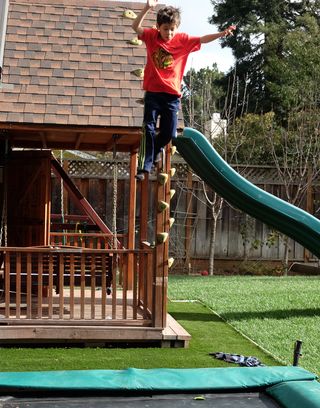School Leadership 2.0
A Network Connecting School Leaders From Around The Globe
One Man’s Way to Create Neighborhood Play for His Kids by Peter Gray
One Man’s Way to Create Neighborhood Play for His Kids

When I give talks to parents’ groups about the benefits of outdoor free play for their kids, the first question asked is often something like this: My child doesn’t want to play outdoors because there’s nobody out there to play with. What can I do about that? Invariably, as part of my answer, I recommend Mike Lanza’s book,Playborhood(link is external).
Children are designed, by nature, to want to play with other children, in their own ways, away from adult interference. That’s how they practice taking control of their own lives, solving their own problems, and getting along with peers. But in today’s world such play does not come easily. As a society we have gone berserk with the idea that the world is too scary for children to run free and that children need constant supervision and direction. So, even those children whose parents allow them to play freely outdoors have a problem. There’s nobody to play with.
When Mike Lanza recalls his own childhood, in suburbs of Pittsburgh in the 1960s and ‘70s, his happiest memories are about adventures with other children, with no adults around. That’s true for most of us who were kids more than three or four decades ago. When Mike became a father, 11 years ago, he was determined to provide his son, Marco, with a childhood of play akin to that which he had enjoyed. He and his wife Perla searched for a home in a neighborhood where children could be seen playing freely outdoors, but they could not find one, at least not in the part of the world where they wanted to live. So, they moved into a neighborhood, in Menlo Park, California, with little traffic and quite a few children—a neighborhood with at least the potential for free play—and then Mike set about turning that neighborhood into a place for play, or, as he calls it, a “playborhood”.
He did this in a number of ways. First, and most important, he turned their front yard into a sort of neighborhood pocket park for kids. The yard isn’t big, but it’s crammed with play opportunities. There’s a fountain and an elevated play river to splash in and float tiny boats down, a smooth concrete driveway for all kinds of hard-surface play, two basketball hoops set at different heights, a large whiteboard and markers for drawing, a picnic table, and benches that serve also as weatherproof toy boxes. From the beginning, the Lanzas spent lots of time in the front yard, for example, eating picnic meals there, so others in the neighborhood would see them and get to know them. They invited neighborhood kids to play there whenever they liked, even when no Lanzas were there. In the backyard they put playthings that were too big for the front, including an in-ground trampoline and a two-story playhouse (see the photo), and neighborhood children were invited to play there, too, whenever they wished.
Because the children in this neighborhood had little previous experience creating their own play, Mike also started and led a small neighborhood summer day camp, held in his yard and on the quiet street in front of it. The idea was to help the kids get started in play—teach them some games and introduce them to some crafts—and then let them go on their own. Mike is not a hundred percent happy with the results; his neighborhood is still not a 1950s, or ‘60s, or ‘70s place where kids run free, chasing one another around blocks and playing in everyone’s yard as if the whole place were one big park. There are still parents who don’t let their kids out without an adult. There are still kids who spend essentially all their time at schoolwork, solitary indoor activities, and being driven to adult-run activities outside of the neighborhood. But, still, there’s much more play going on now than before, and much more than in most other suburban neighborhoods today.
Recently I was in the San Francisco Bay area to give a talk, and, as part of my trip, I visited the Lanzas for a day and stayed overnight with them. Marco is now 11 years old. He’s been riding his bike or scooter to school and back (1.5 miles each way) by himself or with friends since second grade. He’s also been making all of his own play arrangements with friends, with no help from parents, for the past three years or so. One of his current after-school routines is to scooter home and then, from there, scooter with one or more friends to the town skate park, more than a mile away, and play there for an hour or more before returning home. Mike lent me a bicycle so I could follow Marco and his friend on this trip, which I did, from a distance, with the boys’ kind permission. I saw how gracefully they performed scooter tricks in driveways and on steps as they made their way to the park; I watched as they stopped at a bicycle shop on the way, where Marco, on his own, got an inner tube that he needed for some project he was working on at home; and I also saw how careful the boys were when they crossed the busy multilane street they had to cross to get to the park. At the park, Marco and his friend seemed to be the only kids their age or younger who were not attended by an adult. I felt a vicarious thrill as I watched them make their scooters dive and leap at the park.
Mike believes that Marco would not be the physically and socially competent boy he now is if it were not for his (Mike’s) efforts in creating the playborhood. In a recent essay (here(link is external)) he presents evidence that social skills did not come easily or naturally to Marco. It was only through regular, daily experience at play with others that he learned to be socially competent and confident. Marco now has two younger brothers—Nico (age 8, the boy leaping from the playhouse roof to the trampoline in the photo) and Leo (age 6), who have had the playborhood advantage since birth. Mike devoted a lot of effort to create free play in his neighborhood, and now he believes it was all very, very worthwhile.

Not all parents have the means ormotivation to do what Mike has done to enable free social play for their children, but there are other ways to accomplish a similar end. Mike has been more or less a committee of one in his neighborhood, but elsewhere groups of parents have worked together to create safe places to play and to encourage one another to allow their children to play without adult interference. In his book, Mike explains how this was done in seven different neighborhoods—ranging from a poor urban street in the South Bronx to an affluent suburban neighborhood in Palo Alto. His book also deals with the kinds of fears and concerns that naturally arise in the modern mind: What about lawsuits if a child is hurt on your property? What about theft or vandalism of the playthings that are left outdoors for everyone to use? How do you gain the support of neighbors so they don’t complain about noise or about the fact that your front yard doesn’t look like all the other front yards in the area? Such questions can stop people from developing a playborhood even before they start, but Mike explains why they shouldn’t.
If we are going to create a world that is fit for children—a world where children can play and explore with one another as they are designed by nature to do—then we must all make some effort toward that end. We can act at the level of our own homes and immediate neighborhoods, as Mike has done, or we can do so at a broader community level. For example, we can lobby for supervisors in parks, so parents will feel better about letting their children play without their (the parents’) presence. We can insist that sidewalks be created in all residential areas, so even little children can roam safely off the street. We can lobby with local school districts to open up schools for after-school free play, making use of the school’s playground, gymnasium, art supplies, and other play opportunities. What else can we do?

---
What efforts have you made, or have been made by others in your community, to enable free outdoor play? What are your ideas for bringing childhood back to today’s children, so they can grow up to be fully competent adults? Your thoughts, presented in the comments section here, may help improve the lives of children in today’s and tomorrow’s world. This blog is a forum for discussion. As always, I prefer if you post your comments and questions here rather than send them to me by private email. By putting them here, you share with other readers, not just with me. I read all comments and try to respond to all serious questions if I think I have something worth saying. Of course, if you have something to say that applies only to you and me, then send me an email.
JOIN SL 2.0
SUBSCRIBE TO
SCHOOL LEADERSHIP 2.0
Feedspot named School Leadership 2.0 one of the "Top 25 Educational Leadership Blogs"
"School Leadership 2.0 is the premier virtual learning community for school leaders from around the globe."
---------------------------
Our community is a subscription-based paid service ($19.95/year or only $1.99 per month for a trial membership) that will provide school leaders with outstanding resources. Learn more about membership to this service by clicking one of our links below.
Click HERE to subscribe as an individual.
Click HERE to learn about group membership (i.e., association, leadership teams)
__________________
CREATE AN EMPLOYER PROFILE AND GET JOB ALERTS AT
SCHOOLLEADERSHIPJOBS.COM
New Partnership
Mentors.net - a Professional Development Resource
Mentors.net was founded in 1995 as a professional development resource for school administrators leading new teacher induction programs. It soon evolved into a destination where both new and student teachers could reflect on their teaching experiences. Now, nearly thirty years later, Mentors.net has taken on a new direction—serving as a platform for beginning teachers, preservice educators, and
other professionals to share their insights and experiences from the early years of teaching, with a focus on integrating artificial intelligence. We invite you to contribute by sharing your experiences in the form of a journal article, story, reflection, or timely tips, especially on how you incorporate AI into your teaching
practice. Submissions may range from a 500-word personal reflection to a 2,000-word article with formal citations.

You need to be a member of School Leadership 2.0 to add comments!
Join School Leadership 2.0